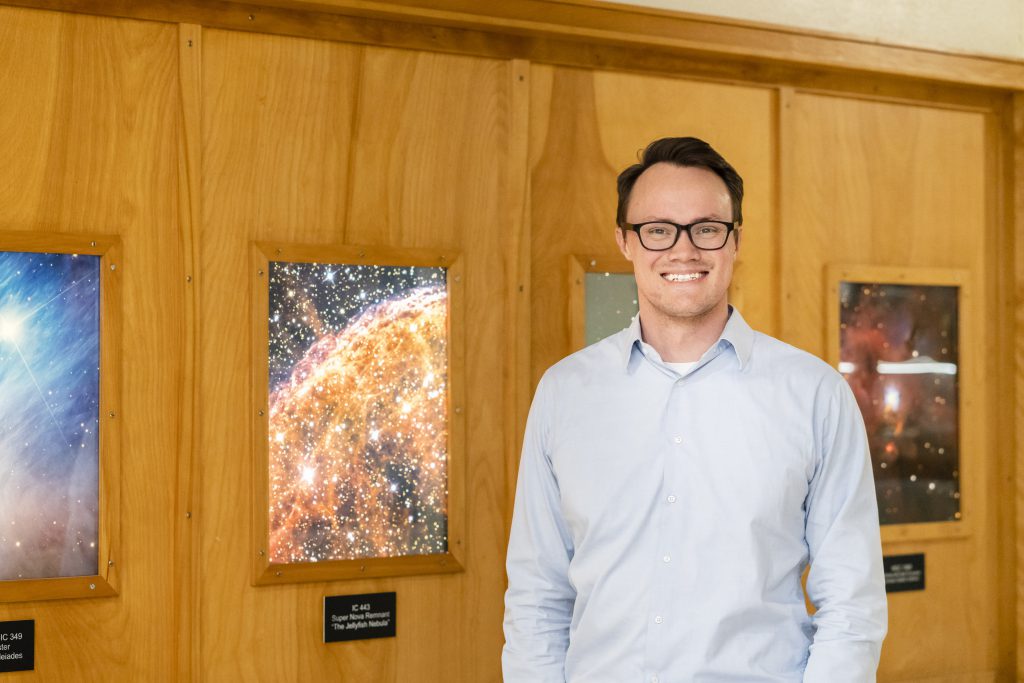
Time Travel Through the Night Sky

Westminster alum and MIT fellow Ben Rackham (’09) offers insight into celestial events
by Liz Dobbins (’21)
Between the pandemic, a hurricane in Utah, major political events, protests, and the storming of the capitol, I think it’s safe to say 2020 and the beginning of 2021 was a lot to handle. A lot of us, including myself, have been grasping for the good in it all—whether that’s re-binging a favorite show or celebrating the small moments. But most of this grasping is done at home, inside, where we’re socially distanced. I’m here to tell you to get out and travel in an unexpected way: go stargazing.
How is this traveling? Well, Ben Rackham (’09), an Honors alum who majored in neuroscience and is a current MIT fellow, connects stargazing with time travel—specifically, when viewing the Andromeda galaxy, the only other galaxy besides our own that is visible by the naked eye. “When you look at the Andromeda galaxy what’s happened is some photon left the surface of most likely a very hot, massive star, cruised across the universe at the speed of light for 2.5 billion years,” Ben says. “When it left that star there weren’t even Homo sapiens on earth. People, as we know them did not exist.”
Star, galaxy, and planet gazing is an easy form of entertainment, a potential hobby, and can be done anywhere. In fact, there are multiple events and sites aside from the Andromeda galaxy that Ben recommends looking for to keep yourself entertained while exploring the night sky. “In the winter months, it’s always a lot of fun to go look at the constellation Orion,” he says.
Orion, known as Orion and His Hosts, is an easily spotted cluster of stars that depicts Orion as a hunter with a bow poised at Taurus the bull. This formation also includes Orion’s guard dogs at his side. But, perhaps the more important celestial being is one specific star trapped within this constellation: Betelgeuse, a giant evolved star. “Betelgeuse is a star at the end of its life—in astronomical terms this means it could blow up any time from today to 30 million years from today,” Ben says. “If it did explode, it’d be a supernova explosion and would be brighter than the full moon.”
If you hate the idea of potentially waiting your whole life to see this explosion you can also search for the International Space Station. Orbiting every 90 minutes, it can be seen just after sunset or just before sunrise and is a fun sight for kids. The space station will be the brightest object in the sky at that point, blinking light from the sun down to Earth.
Time travel, explosions, and man-made space stations all from your backyard make staying at home seem great. Well, if you really want to get out while remaining socially distant, national parks or mountain tops away from city lights make the experience that much better. In fact, with the right pair of binoculars or a small telescope you can even see the rings of Saturn. “There are two groups of people on planet earth: those that have seen Saturn’s rings with their eyes and those that haven’t,” Ben says. “Once you see it, it’s this incredible secret in the sky.” However, to join the club of those that have seen Saturn’s rings, you need to stabilize your binoculars and make sure it’s fall—the time of year it’s visible at night.
Not willing to wait until fall? Try your luck at seeing a full eclipse in May. “Eclipses happen twice a year near the summer solstice and the winter solstice,” Ben says. “What occurs is the sun, earth, and the moon are aligned—in that order. Normally we’re looking at the full face of the moon reflecting sunlight back at us, but near the solstice the orbit of the moon passes through Earth’s shadow.”
All of these events are only a very small portion of what you can observe in the night sky. Luckily, we have technology to help us see, find, and decipher all that’s going on. Ben recommends the following:
- Use a green laser to point at objects in the sky
- Take a picture of the sky using night mode and long exposure on newer phones
- Mount your telescope of binoculars to stabilize your view
- Let your eyes adjust away from all light for 20 to 30 minutes to fully optimize your night vision
- Download constellation-finding apps to help you map the sky
The night sky is a vast place of possibilities and it’s accessible to any person. Whether you’re living in a city or can escape away from the lights, there’s something to see. So, get out of your house and take a walk through time, see a supernova explosion, watch our technology orbit Earth, or see the biggest secret in the sky.
Online Resources
Find the best place to stargaze: darkskymap.com
Track the orbit of the space station: spotthestation.nasa.gov
Discover when you can see an eclipse: eclipse.gsfc.nasa.gov
About the Westminster Review
The Westminster Review is Westminster University’s bi-annual alumni magazine that is distributed to alumni and community members. Each issue aims to keep alumni updated on campus current events and highlights the accomplishments of current students, professors, and Westminster alum.
GET THE REVIEW IN PRINT Share Your Story Idea READ MORE WESTMINSTER STORIES